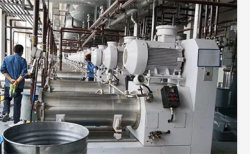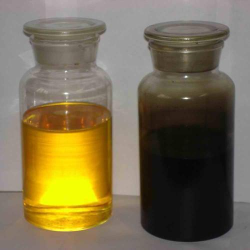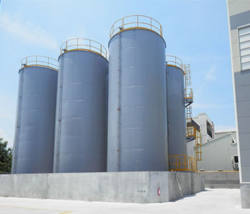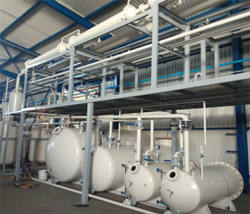2022-02-08
Waste oil is a two-sided body with dual characteristics of pollution and resources: improper handling will cause environmental pollution, and recycling and recycling will save energy and relieve the pressure of resource shortages. According to the "National Catalog of Hazardous Wastes", waste mineral oil is classified as hazardous waste, numbered HW08. At present, the vast majority of waste oil in China is reprocessed after being recycled by a Waste Oil To Diesel Refinery Machine and turned into base oil for reuse.

Current status of waste oil recycling
In foreign countries, waste oil recycling work started earlier. In the 1960s, some developed countries in Europe and the United States had already begun research, and since then they have accumulated valuable experience. Until now, Western countries have been in a leading position in the waste oil recycling industry and even the entire petroleum industry. The reasons for their success are related to the improvement of policies and government subsidies. However, in China, the reasonable recovery rate of waste oil is not high, which is mainly affected by relevant national and local industry policies and regulations, upstream waste oil recycling links, downstream regeneration technologies, and other restrictions.
Although China's petroleum industry has been promoting policy formulation and implementation, from the current point of view, although policies and regulations have guiding significance, they are not enforced, and there are no severe penalties and certain financial incentives, resulting in many difficulties in operation. . Due to the large area of the country, the investment and understanding of waste oil recycling and regeneration vary from place to place, and the implementation is different. This has caused the waste oil recycling industry to encounter many difficulties in the recycling process. Except for the special oil field, other industries are difficult to recycle. It is quite large, mainly with the following problems:
(1) No sorting and recycling, various mixed oil varieties, and different waste oil performance indicators. Different types and proportions of waste oil are mixed, which makes subsequent regeneration treatment more difficult;
(2) Transportation is restricted. The composition of waste oil is complex, containing different pollutants and impurities that may cause corrosion and scaling of storage tanks. Therefore, transportation equipment should be anti-corrosion and explosion-proof at the same time. However, currently, waste oil recovery agencies rarely have such special equipment;
- Disposal of violations. If the auto repair industry has no qualified unit nearby that can handle the hazardous waste generated by the auto repair industry, the long distance between the compliant unit and the long transportation distance, resulting in high transportation and disposal costs, the waste engine oil will be transferred without going through the transfer procedures. Deal with other oil companies, and even sell it to waste collectors at will.
The most commonly used waste oil recycling process in China
The solvent refining process is still one of the mainstream industrial diesel production methods. The principle of solvent refining is to utilize the different solubility characteristics of certain organic solvents on the hydrocarbons contained in waste lubricating oil with additives, oxidation products, sludge, etc., under certain conditions, to remove additives, oxidation products, sludge, etc. in waste oil Impurities are removed, and then the solvent is distilled to recover and a crude product is obtained. The crude product is refined by clay to become regenerated oil.
In foreign countries, solvent extraction machines are often the first choice for waste oil recovery and processing. It uses solvent extraction technology to refine the waste oil into reusable base oil. Solvent extraction has gradually changed from propane to the use of N-methyl pyrrolidone and furfural as solvents in the refining process. Among them, N-methyl pyrrolidone is widely used. Its quality is better than other solvents because it has the lowest toxicity and can be used at a lower consumption-to-oil ratio, thereby saving energy. In China, the main research is to use alcohol and ketone mixtures (isopropanol, acetone, etc.) as refining solvents, which can reduce coking and scaling problems in the subsequent solvent recovery and distillation processes.
Although the solvent refinement process has all the above advantages, there are still some problems that cannot be solved at the same time. The disadvantage of solvent refining technology lies in the dependence of the quality of refined oil on the quality of raw materials because this process is a physical process and does not involve any chemical reactions. At the same time, the agent-to-oil ratio remains high during the refining process, and the large-scale use of this toxic solvent will cause serious harm to the environment and equipment. The unstable price fluctuation and high unit price of the promising N-methyl pyrrolidone solvent are also some of the reasons that restrict the development of this process. Although the solvent can be recycled and reused, it is difficult to recycle, the cost of recycling is also high, and the recovery rate of oil samples is not ideal.
Nowadays, both at home and abroad have begun to study how to improve the solvent refining process, most of which will involve the use of additives. A simple understanding of the auxiliary technology is to add a certain amount of a suitable auxiliary in the solvent refining process to solve the various problems that often occur in the solvent refining process, to obtain better refining results. However, most of the current research on additive technology is still limited to preliminary research in the laboratory, and it is still difficult to achieve in scale-up experiments and industrial use. Therefore, additive technology still has great research value.
Summarize
China has begun to attach importance to the progress of the waste oil recycling industry. This is a business that benefits the country and the people. We must vigorously develop waste oil recycling from the perspective of oil resource conservation and environmental protection. The sources of waste oil in our country are scattered, there are many varieties and the classification and recycling are not achieved. The phenomenon of illegal disposal is everywhere. The supply of raw materials for recycling companies is very difficult. Therefore, it is difficult to establish large-scale centralized treatment plants. Intermittent production method. Because of this, some advanced foreign technologies are not suitable for use in our country. If these SMEs want to succeed, they must control waste oil production and recycling from the upstream, establish a waste oil recycling system, provide sufficient raw material protection for subsequent regeneration processing, eliminate outdated technology, and use acid-free products that are in line with international standards. Craft.
Sulfuric acid-white clay treatment was the first petroleum regeneration process used, but it has been gradually replaced by new technologies such as solvent extraction and hydroprocessing. Most current solvent extraction technologies use propane and isopropanol as solvents, but it has low selectivity to non-ideal components and requires a high agent-to-oil ratio, which increases energy consumption. Hydrogenation refining can reduce the loss of effective substances in oil samples, increase the yield of recycled waste oil, and will not produce a large amount of waste white clay during the white clay refining process and pollute the environment. Therefore, the hydrogenation supplementary refining process has gradually replaced white clay. Refining, but due to the excessive capital investment and operating restrictions required for hydro refining, can no longer be widely used in small and medium-sized enterprises.
Thin-film evaporation technology needs to add post-processing steps and needs to be combined with other technologies, but these transformations will increase operating and capital costs, making this economically less attractive. Most processes use a combination of different technologies, such as solvent extraction and hydrofining, thin-film evaporation, and different refining processes and hydroprocessing. However, from the analysis of the current status of domestic waste oil regeneration, the most attractive method for refining waste oil can be a combination of solvent extraction and membrane separation. It should explore the best solvent and solve the problems in membrane treatment. Intensify research efforts.




